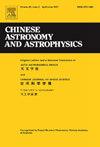QSO SDSS J142225.03+535901.7中宽吸收谱线的多时期光谱变异性分析
Q4 Physics and Astronomy
引用次数: 0
摘要
类星体中的宽吸收谱线(baals)是证明物质外流存在的最有力的观测证据之一。bal通常表现出光谱变化,分析这种变化有助于限制这些流出的物理模型。来自类星体中心引擎的电离连续体的变化被认为是驱动大多数BAL变化的主要机制。如果类星体中的BAL吸收波谷在同一方向上以不同速度同时变化(减弱或增强),则极有可能BAL的变化主要是由电离连续体的变化引起的。类星体SDSS(斯隆数字巡天)J142225.03+535901.7具有55个高信噪谱期,显示出BAL变异性。BAL各速度分量的等效宽度与连续体亮度之间存在显著的反相关(Spearman’s相关检验,非相关概率p值小于0.05)。这些组分的等效宽度与连续体的光谱指数之间没有显著的反相关关系,排除了等效宽度与连续体光度之间潜在的负相关关系是由尘埃气体沿视线垂直运动引起的。因此,可以推断,该源BAL的变化主要是由电离连续体的变化驱动的。本文章由计算机程序翻译,如有差异,请以英文原文为准。
Multi-epochs Spectral Variability Analysis of Broad Absorption Lines in QSO SDSS J142225.03+535901.7
Broad absorption lines (BALs) in quasars are among the most compelling observational evidence for the presence of outflows. BALs commonly exhibit spectral variability, and analyzing such variations helps to constrain the physical models of these outflows. Variations in the ionizing continuum from the central engine of quasars are thought to be the primary mechanism driving most BAL variability. If the BAL absorption troughs in a quasar simultaneously vary (either weakening or strengthening) at different velocities in the same direction, it is highly likely that BAL variability is primarily induced by variations in the ionizing continuum. The quasar SDSS (Sloan Digital Sky Survey) J142225.03+535901.7, with 55 epochs of high signal-to-noise spectra, displays BAL variability. There is a significant anticorrelation (Spearman's correlation test, with a non-correlation probability -value less than 0.05) between the equivalent widths of various velocity components of the BAL and the continuum luminosity. There is no significant anticorrelation between the equivalent widths of these components and the spectral index of the continuum, ruling out that the potential negative correlation between equivalent width and continuum luminosity is caused by the vertical motion of dusty gas along the line of sight. Therefore, it can be inferred that the BAL variability in this source is primarily driven by changes in the ionizing continuum.
求助全文
通过发布文献求助,成功后即可免费获取论文全文。
去求助
来源期刊

Chinese Astronomy and Astrophysics
Physics and Astronomy-Astronomy and Astrophysics
CiteScore
0.70
自引率
0.00%
发文量
20
期刊介绍:
The vigorous growth of astronomical and astrophysical science in China led to an increase in papers on astrophysics which Acta Astronomica Sinica could no longer absorb. Translations of papers from two new journals the Chinese Journal of Space Science and Acta Astrophysica Sinica are added to the translation of Acta Astronomica Sinica to form the new journal Chinese Astronomy and Astrophysics. Chinese Astronomy and Astrophysics brings English translations of notable articles to astronomers and astrophysicists outside China.
 求助内容:
求助内容: 应助结果提醒方式:
应助结果提醒方式:


